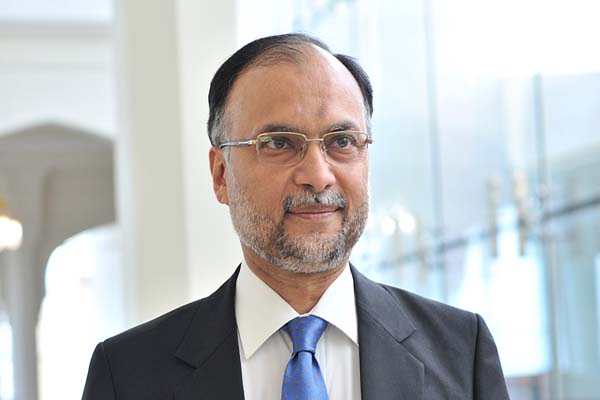The federal government is going to present Rs 2113 billion worth development budget for the next financial year which includes Rs 1001 billion of federal public sector development programme (PSDP) and Rs 1112 billion of provincial PSDP.
This was said by Minister for Planning and Development Ahsan Iqbal while talking to media after the daylong meeting of Annual Plan Coordination Committee (APCC) held at the ministry on Wednesday.
He said that approved development projects and budget would be presented at National Economic Council’s meeting to be chaired by the prime minister as chairman of the council on Friday for final approval.
According to sources, the overall size of the PSDP for 2017-18 of the federal government was at least 25 per cent higher as compared to Rs 800 billion of the current fiscal year. Similarly, the proposed fund for annual development plans (ADPs) of provinces in next financial year was also 32 per cent higher against Rs 875 billion allocations for the current year.
Earlier, the meeting was briefed by the minister that 2016-17 has witnessed the GDP growth rate at 5.28 – the highest growth rate in the past 9 years. The minister claimed that expansion in the industrial sector, the revival of agriculture, significant growth in services, construction and electricity generation, large-scale manufacturing sectors, restoration of peace, macroeconomic stabilisation and fiscal consolidation were the reason behind the growth in GDP.
The ministry said that China-Pakistan Economic Corridor (CPEC) has the potential to further spur GDP growth and transform Pakistan into a regional economic hub. The early harvest energy projects under CPEC will have a discernible impact on the economy. The energy and infrastructure projects are expected to attract foreign direct investment and bridge the energy shortfall. The enhanced power generation capacity resulting from CPEC projects is thus expected to augment growth in the medium to long term.
Referring to various surveys and report, the minister claimed Pakistan’s ranking in terms of Global Competitiveness Index (GCI) improved at 122nd position in 2016-17 compared to the 126th position in 2015-16 amongst 138 countries. Similarly, position in the Doing Business global rankings improved from 148th to 144th. Standard & Poor’s upgrading of Pakistan’s long-term credit rating from B minus to B, and improved ranking on Travel and Tourism Competitiveness Index (2017) at 124th in 136 countries are encouraging signs. According to Global Entrepreneurship Monitor (2017), Pakistan has the second highest ‘perceived opportunity and capability’ after Iran when compared with Iran, China, Malaysia, and Singapore.
According to the minister, the overall sentiment of the economy is upbeat. Pakistan Stock Exchange was the best performing market in Asia in 2016. The significant boost to the market has come from the sale of 40 per cent strategic shares of Pakistan Stock Exchange (PSX) to a Chinese Consortium – the first venture of Chinese bourse outside China.
Single digit inflation at 4.1 per cent during July-April 2016-17 is a positive sign. Nielsen Global Survey of Consumer Confidence reports the highest value for consumers’ confidence index in December 2016since 2008. The national Consumer Confidence survey also depicts an improving consumer demand as consumer confidence index registered an all-time high of 176.5 points in March 2017. This reflects the favourable conditions in the economy owing to improved security, better energy supply, low inflation and increased tourism among other factors.
Policy rate stands at a multi-decade low level of 5.75 per cent. The lower policy rate gradually translated into lowest lending rates in 10 years i.e. 7.1 per cent and 8.6 per cent weighted average lending rates on gross and outstanding loans respectively in March 2017. Private sector credit is also responding well to the record low policy rate and is expected to gain momentum in the coming months.
The private sector is availing credit not only for working capital requirements but also for fixed investments. The expansion in private sector credit was higher in July-March 2016-17 compared to the same period last year. A considerable reduction in government borrowings from scheduled banks, coupled with an increase in bank deposits spurred private sector credit. Moreover, loans for fixed investments increased by Rs 161.1 billion in the first 8 months of FY17, compared with an expansion of Rs 98.3 billion in the same period of last year. This indicates that private sector is borrowing for upgrading and expanding businesses.
The improvements in LSM, expansion plans announced by major industries and favourable monetary conditions are expected to provide continued momentum in the demand for credit. The over-all output of Large Scale Manufacturing Industries (LSM) increased by 5.06 per cent for July-March 2016-17. The LSM growth was significantly high in March 2017 at 10.5 per cent compared to 9.1 per cent in March 2016. Iron and steel products (16.6 per cent), Electronics (15.2 per cent) and Automobiles (11.3 per cent) are the main contributors to growth.
In view of the above, the ministry of P&D claims that the economic growth prospects are positive for 2017-18 due to better prospects in the agriculture sector, a strong performance of the industrial sector, pickup in private sector credit, macroeconomic stabilisation, politically stability and an improved security situation. “However, we are mindful of the challenges ahead. Despite the encouraging scenario, the widening current account deficit is a challenge and needs to be addressed. The external deficit can exacerbate as the oil prices are expected to increase in 2018. However, these risks will be offset by increasing exports and more FDI. Our priority is to generate higher revenues by broadening the existing tax base, simplifying the tax structure and strengthening tax administration. Therefore, growth prospects for Pakistan are bright,” he concluded.




